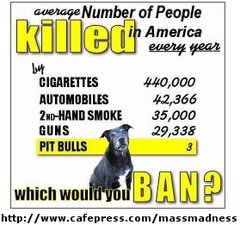Court Report May 18th
Here is my summary of the morning of May 18.
Legalities require me to tell you that I'm not a lawyer and this document contains only my interpretations of what was said in court and my opinions. Nothing in this document should ever be construed as advice. This applies to my previous posts as well and they will be modified to note this.
Well, they sure managed to fit a lot into two and half hours this morning.
CROWN ATTORNEYS
The crown started with the arguments about "trial fairness", which was Clayton Ruby's third reason for unconstitutionality.The crown argued first about Section 19 of the DOLA, where a document from a vet can be entered into evidence as "proof" that the dog is a pit bull. Ruby's argument was that cross-examination of a document was not possible and that, even if the vet is called as a witness, because the defendant would have to call the witness, the defence can only examine the witness "in chief", not cross-examine him. This means that it is dependent on the judge as to how "rough" the defence can get with the vet.
Crown pointed to the section Provincial Offences Act (POA) that applies to proceedings under DOLA. Part IV, Section 46, subsection 2 says that the defendant is entitled to make full answer and defence. Subsection 3 says that the defence may examine and cross-examine witnesses. Ruby responds to this later on.Then the question was "how do we get a vet into court?"
The answer is that the defence may issue a summons. What does it cost to get a vet? The court costs are $5.00 (i.e., not prohibitive) and are only applied upon conviction.
Also, the defendant could easily bring a motion before the judge to allow cross-examination (i.e., treat the witness as hostile).
Even without cross-examination, the defence could still put contradictory evidence to the witness and, if the witness is hostile, request permission to cross-examine.The crown's basic argument is that, in order for cross-examination to NOT be possible, the legislation would have to EXPRESSLY prohibit it, which the DOLA does not.
Now to Section 1 of the charter (reasonableness):
According to the crown (which Ruby later challenges), the onus is on the applicant (us) to establish that there has been a violation of the charter. In this case, what the crown is saying is that it's not the crown's responsibility to prove that the legislation is reasonable. It's the applicant's responsibility to prove it isn't. Ruby disagreed with this (later) and provided arguments to the contrary.The key to reasonableness is "harm to society". The government has to prove a reasonable apprehension of harm.Then he went off on a tangent for a second to talk about whether the judge should allow him to bring into evidence the legislative committee transcripts. He provided 3 case histories that allowed legislative committee transcripts into evidence. Ruby later attacked all 3 cases as irrelevant to this case.
The judge noted that the only time legislative committee transcripts are allowed to be used as evidence is to help with determining the INTENT of the legislation. She noted that there is no dispute among anybody about the INTENT of this legislation (i.e., reduction of harm to society), so why do we need the transcripts? No real answer from the crown on this.Back to Section 1 of the charter.
Section 1 requires a "proportionality analysis" to determine if the legislation is reasonable in its attempts to achieve its objective.The proportionality analysis consists of three parts:
1. There must be a rational connection of the challenged portion to the purpose of the legislation. In this case, the challenged portion is the banning and restrictions of pit bulls. The purpose of the legislation is dog bite reduction and public safety. Is there a rational connection between banning pit bulls and increasing public safety?
2. The legislation must minimally impair the lives of those it affects. This brings in the discussion of alternative measures that the government did or did not consider. Does banning pit bulls minimally impair those it affects compared to other, more generic, legislation?
3. The legislation must be proportional to the risk of harm. Is banning pit bulls an overly extreme measure considering the risk of harm from the dogs?
Rational ConnectionUsing a case related to obscenity charges for pornography (which was used throughout this case), the court in that case noted that, while there is NOT direct link between obscenity and harm to society, it is reasonable to assume that exposure to certain images could change a person's attitude towards the group depicted in those images (specifically women and children).
In the face of insufficient social or scientific evidence, it is sufficient that Parliament had a reasonable basis for assuming harm. Parliament does not need proof in order to reasonably predict harm. The government is afforded a margin of appreciation to achieve their objective of public safety. Although there was no conclusive proof of harm, the legislation could reasonably conclude that there was harm. In our case, the crown contends that their proof is actually better than the proof that was in the obscenity case and that legislation was upheld.
The judge responded by stating that the issue is not whether pit bulls cause harm, but whether it is JUST pit bulls causing harm or whether other dogs could cause or have caused similar harm. She asked the question "is that harm caused because the dogs are pit bulls"?
Minimum Impairment
There is no constitutional right to own a pit bull. This was reiterated throughout the case by the crown. I find it interesting that Ruby has never stated that we have a constitutional right to own a dog. He is saying that we have a constitutional right to NOT be imprisoned for owning a certain type of dog.
Leashing, muzzling, sterilizing constitute reasonable impairment.
Courts have held that Parliament must be given some leeway in restricting the public in order to prevent harm to the public.
Back to the obscenity law, many of the alternatives are RESPONSES after the harm has occurred. The judge responded "if one could determine ahead of time, through a temperament test, prior to an attack, if a dog was dangerous or likely to attack, would that not be a reasonable alternative and impair less? Also, would obedience school prevent attacks"
The crown replied that there is no evidence presented to this particular court that obedience training prevents attacks.
Crown: Pit bulls are unpredictable. There is no warning of attack.
Judge: Saying that there is no warning of attack at the time of the attack is not the same thing as saying that dog cannot be assessed for dangerousness [using a temperament test].
Crown agreed.
Crown quoted AVMA report (Dr. Clifford) stating that pit bulls attack without giving warning signals. He quoted another AVMA report (Carl Seminac sp?) and Richard Stratton's book stating that both purebreds and crossbreeds are unpredictable. The Clifford report also discussed the wisdom and policy of allowing inexperienced vets to handle pit bulls, given that they are unpredictable and attack without warning. The Clifford report also stated that pit bull bites are more serious that other bites, directly contradicting Dr. Brisbin's that the "bite and hold" tendency of pit bulls actually causes less damage than the "slash and tear" of other breeds.
Proportionality (Balancing)
The effects of the law so severely infringe on the right of the individual that it is grossly disproportionate to the positive effects of the law. Crown's argument is that the harm is severe enough and the restrictions reasonable enough that this legislation is proportional.
Federalism (Animal Pedigree Act)
In order to discuss a conflict between provincial and federal legislation, there must first be an assumption that both pieces of legislation are constitutionally valid. In this case, the constitutionality of the provincial legislation is in question, so this argument regarding federal paramountcy may be moot.Also noted that Attorney General of Canada has not requested to intervene in this case, which he might have done if he felt that the two pieces of legislation conflicted.
Quote from a Supreme Court decision: "Courts should be particularly cautious about invalidating provincial legislation due to paramountcy if the federal government has not intervened".Section 95 of the Constitutional Act of 1867: Each province may make laws in relation to agriculture. Any laws of the province are valid in as far as it is not repugnant to a federal Act of Parliament. Where there is inconsistency, the provincial legislation is inoperative to the extent of the inconsistency. It is only inconsistent when it is impossible to obey both laws.
A federal law regulating a field does not necessarily "occupy the field" (i.e., prevent provincial legislation from addressing the same field). The purpose of the APA is to promote the purity of a breed and only this purpose should be considered when determining paramountcy. The purpose of the DOLA is public safety whereas the APA's is commerce and agriculture. Because of these two entirely different purposes, they can co-exist and be obeyed simultaneously.In the Rothman's case (Saskatchewan Tobacco Control Act) where provincial legislation prohibited retail tobacco displays while the federal legislation did not, the provincial legislation simply prohibited something that the federal legislation did not. Both could be obeyed because they did not expressly conflict.
Final CommentsJudge: "Are there any sections that, if found unconstitutional, the crown would be willing to sever?"
Crown focused particularly on jail time and on the vet's certificate (i.e., bring a vet into court to testify instead of just a document). Basically, he left it up to the judge.
CLAYTON RUBY
Severability
The judge has no option to sever parts of the legislation. It was not requested by the applicant. The only option to the judge is to make a decision if the entire legislation is constitutional or not. If severability becomes an issue, then this must be approached carefully because of the complexity and arguments will have to be made from both sides on that issue.
Legislative Committee Transcripts
In the cases listed by the government, the legislative committee transcripts were only used to determine the scope of the legislation, not the wisdom or the facts. In our case, nobody is question the purpose of the legislation.
Quote from Ruby
The government is asking the judge not to make any findings of fact. In fact, they're saying "For God's sake, don't make any findings of fact!" This is because the facts are not on their side. The whole point of their argument is "We're the government. Trust us!"
Reasonable Apprehension of Harm
Regarding the legislature having a "reasoned apprehension of harm", it appears that the cases to which this has applied in the past have all talked about trying to estimate what harm might occur based on certain actions or legislation. These cases did not have existing evidence of harm. They had to guess what the future harm might be. In our case, we have evidence of harm from all breeds, including the pit bull attacks listed by the crown. So there is no need for a reasoned apprehension of harm. The legislature should have given more attention to the existing evidence instead of just guessing at the possibility of future harm.
Core vs. Periphery
There had been quite a bit of discussion about this earlier, which I hadn't really covered. Ruby's point had been that there are a lot of dogs that "sit on the edge" of the definition of pit bull (the periphery). The core are the dogs that are one of the three listed breeds. Much of the reason for the arguments from the crown about trying to prove that "pit bull" is a commonly used word that everyone understands is so that a lot more dogs could get thrown into that definition, thus making the "core" bigger. One of the tests of reasonableness or proportionality is how big the core is compared to the periphery. How many dogs are guaranteed to fit the definition and how many dogs MIGHT fit the definition?
To show that the core in this case is insignificant, Ruby listed the registrations last year for Amstaffs and Staffy Bulls in Ontario (2 and 114 respectively). These dogs are insignificant in the population as a whole and are also not the problem, being purebreds that are unlikely, based on existing statistics, to ever be involved in a bite incident. "Pit bull terrier" and "substantially similar", on the other hand, are clearly definitions designed to catch as much of the periphery as possible.
The DOLA does not require the judge to consider the breed standards, unlike the Winnipeg bylaw which does.
In the cases of the challenges to the Winnipeg bylaw and to a Quebec municipal bylaw, the courts must start by assuming that the bylaws are valid and are the will of the people. Then they must be proved to not be. This is the exact opposite of what's required here. The government must prove that their law is constitutional when it comes to Section 1 of the charter.
In the cases where "substantially similar" or like phrases have been challenged and rejected, the purpose of the legislation must help interpret that phrase. In this case, the purpose of the legislation (danger) cannot help with the interpretation of "substantially similar physical characteristics" because all the evidence shows that you cannot determine the dangerousness of a dog by its physicality.
Canadian evidence (Zaharchuk) takes priority over U.S. evidence (Beck and Skeldon).
Bite Victims
The bite evidence of the victims cannot assist the court in the two questions:
1. Is the ban necessary?
2. Is it reasonable? (I think that's what Ruby said)
Section 1 Onus
Also, the onus is on the crown to prove that the legislation is reasonable under Section 1 of the charter.
Provincial Offences Act (Trial Fairness)
There is no right under this legislation to cross-examine the veterinarian who provided the document. It is only a privilege. Thus, it violates a defendant's right to make full answer and defence.
Rational Connection
If significant harm can and has been caused by all breeds of dog, then rational connection is lost between the harm to society and the ban on pit bulls.
Regarding pit bulls attacking without warning, specifically regarding temperament testing, Ruby discussed the American Temperament Testing Society results. He also quoted the Ohio case, where all experts except one agreed that all dogs give warning signs before biting.
In response to the crown's suggestion that alternatives other than banning pit bulls were in RESPONSE after attacks have already occcurred, Ruby notes that other portions of the DOLA allow for proceedings against an owner before an attack ever occurred (menace to public safety, failure to prevent a dog from being a menace to public safety).
Federal Paramountcy
The federal government has not intervened in this case for EITHER side. It is not here supporting the provincial government either. No conclusion can be drawn in favour of the crown just because the federal government has not intervened. Its own legislation is not at risk, so it doesn't need to intervene.
COURT IS FINISHED
Judge reserved her decision. We have no idea on timeframe for a decision. We should expect at least two or three months, maybe longer.
I am going to try to get the names of the judge and the crown attorneys for historical purposes.
Over and out. I'm going to bed.
Steve






























No comments:
Post a Comment